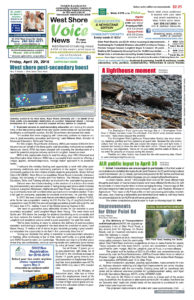LANGFORD GROWTH: West shore post-secondary boost with funds to Royal Roads University

“I’m excited that we’re engaging with community partners to improve access to post-secondary education and training,” said Melanie Mark, Minister of Advanced Education, Skills and Training.
For this project, Royal Roads University (RRU) will receive $250,000 from the province on behalf of the three public post-secondary institutions on southern Vancouver Island. RRU has been charged with managing the development of a report for potential program delivery options in Langford, based on need.
RRU is the appropriate choice to lead the study, says RRU President and Vice-Chancellor Allan Cahoon. RRU has a successful track record for offering a unique, applied, demand-responsive, ‘change maker’ approach in its academic model.
“I welcome the ministry funding and opportunity to work with other post-secondary institutions and community partners in the region,” says Cahoon. Community partners for this initiative include students and parents, Sooke School District 62 (SD62), West Shore municipalities, Royal Roads University, Camosun College, the University of Victoria and First Nations. The Ministry of Advanced Education, Skills and Training will also be involved in the local planning process.
 Cahoon sees the initiative leading to the creation of a solution that meets the post-secondary educational needs of fast-growing west shore which includes Colwood, Langford, Metchosin, Highlands and View Royal.“This is about supporting a community need with a collaborative approach and innovative solution. That’s a net gain for everyone, especially for students and families,” he said this week.
Cahoon sees the initiative leading to the creation of a solution that meets the post-secondary educational needs of fast-growing west shore which includes Colwood, Langford, Metchosin, Highlands and View Royal.“This is about supporting a community need with a collaborative approach and innovative solution. That’s a net gain for everyone, especially for students and families,” he said this week.
In 2017, the west shore area had an estimated population of about 74,000, while Sooke has a population nearing 14,000. For the City of Langford (itself with a population over 40,000) the annual average population growth rate over the last 10 years was 4.7%, making it one of the fastest growing regions in BC.
“We need to guarantee easy affordable access for our students to post secondary education,” said Langford Mayor Stew Young. “The west shore and Sooke are 19% below the average for students transferring on to university and we must remove the barriers and find the solution to get more students from Langford and westshore area to enroll in post secondary,” he said this week.
“We’ve been looking at ways to advance the delivery of post-secondary education and training to programs in the west shore for a number of years,” said Mayor Young. “It makes a lot of sense to give students pursuing a post-secondary education the opportunity to do that in the community they live in.”
“Giving our students the ability to transition to post-secondary education or training, while continuing to live in their home community, is a great option,” said SD62 Superintendent Jim Cambridge. “Students can stay in a familiar place where they are comfortable, continue working locally and potentially save money by living at home,” said Cambridge.
Not all Grade 12 grads go on to post-secondary right away. As of 2013-2014, the provincial average of Grade 12 grads going directly into post-secondary in September following their June graduation was 49.7% while SD62 only saw a 38% transfer rate.
According to BC Ministry of Education stats, after two or three years (for employment, travel or life in between), there is also a significant number of high school grads who return to the education system in post-secondary.
// This article was also published on page 1 of the April 20, 2018 issue of West Shore Voice News.
// Back to the main page of this website
// Back to the Langford/Colwood news page

